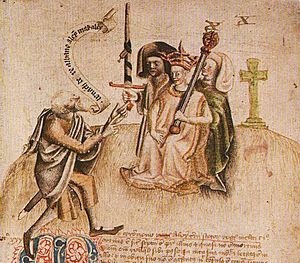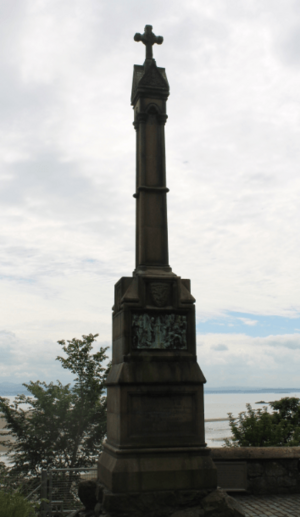Alexander III of Scotland facts for kids
Quick facts for kids Alexander III |
|
|---|---|

Coronation of King Alexander on Moot Hill, Scone. He is being greeted by the ollamh rígh, the royal poet, who is addressing him with the proclamation "Benach De Re Albanne" (= Beannachd Dé Rígh Alban, "God Bless the King of Scotland"); the poet goes on to recite Alexander's genealogy. By Alexander's side is Maol Choluim II, Earl of Fife holding the sword.
|
|
| King of Scots | |
| Reign | 6 July 1249 – 19 March 1286 |
| Coronation | 13 July 1249 |
| Predecessor | Alexander II |
| Successor | Margaret |
| Born | 4 September 1241 Roxburgh Castle, Roxburghshire, Scotland |
| Died | 19 March 1286 (aged 44) Kinghorn Ness, Fife, Scotland |
| Burial | 29 March 1286 Dunfermline Abbey |
| Spouse |
|
| Issue More |
Margaret, Queen of Norway Alexander, Prince of Scotland |
| House | Dunkeld |
| Father | Alexander II |
| Mother | Marie de Coucy |
Alexander III (born 4 September 1241 – died 19 March 1286) was the King of Scots from 1249 until his death. He is famous for signing the Treaty of Perth. This agreement gave Scotland control over the Western Isles and the Isle of Man. Sadly, his only grandchild and heir, Margaret, Maid of Norway, died before she could become queen.
| Top - 0-9 A B C D E F G H I J K L M N O P Q R S T U V W X Y Z |
Becoming King
Alexander was born in Roxburgh. He was the only son of King Alexander II and his second wife, Marie de Coucy. When his father died on 6 July 1249, Alexander became king at just seven years old. He was crowned at Scone on 13 July 1249.
During his childhood, while he was too young to rule, two groups fought for control of Scotland. One group was led by Walter Comyn. The other was led by Alan Durward. At first, Comyn's group had more power.
In 1251, Alexander married Margaret of England. She was the daughter of King Henry III of England. Henry tried to make Alexander promise loyalty to him for the Scottish kingdom. But Alexander refused. Later, in 1255, Durward's group gained more power. However, both groups eventually agreed to share power in a special council that ruled for the young king.
Taking Control
When Alexander turned 21 in 1262, he decided to finish a plan his father had started. This plan was to take control of the Western Isles. These islands were then ruled by Norway. Alexander formally asked the Norwegian king, Haakon IV, to give up the islands.
King Haakon said no. The next year, he launched a large invasion fleet. Haakon sailed around the west coast of Scotland and stopped near the Isle of Arran. Alexander cleverly delayed talks until autumn storms began. Haakon finally attacked, but a terrible storm damaged his ships. The Battle of Largs in October 1263 was not a clear win for either side. But Haakon's fleet was in a bad situation. He turned back home but died in Orkney in December 1263.
With Haakon gone, the islands were open for Alexander to claim. In 1266, Haakon's successor signed the Treaty of Perth. This treaty officially gave the Isle of Man and the Western Isles to Scotland. Scotland paid money to Norway for them. Norway kept Orkney and Shetland until 1469.
Family and Succession
Alexander married Margaret of England on 26 December 1251. She was ten, and he was eleven. They had three children:
- Margaret (born 1261 – died 1283), who married King Eric II of Norway.
- Alexander, Prince of Scotland (born 1264 – died 1284).
- David (born 1272 – died 1281).
Sadly, Queen Margaret died in 1275. All three of Alexander's children also died within a few years. This made the question of who would rule next very important. In 1284, Alexander convinced the Scottish Estates to name his granddaughter, Margaret, Maid of Norway, as his heir. She was the daughter of his oldest child, Margaret.
To try and have a male heir, Alexander married again. He married Yolande de Dreux on 1 November 1285.
Alexander's Death

Alexander died on 19 March 1286. He was riding his horse in the dark to visit Queen Yolande in Kinghorn, Fife. The next day was her birthday. He had spent the evening at Edinburgh Castle celebrating his new marriage. He was warned not to travel because of bad weather. But he crossed the Forth from Dalmeny to Inverkeithing anyway.
In Inverkeithing, he insisted on continuing his journey. Even a local person, Alexander Le Saucier, warned him. Le Saucier told the King, "My lord, what are you doing out in such weather and darkness? How many times have I tried to persuade you that midnight travelling will do you no good?"
But Alexander ignored the warnings. He rode off with his group and two guides. The King got separated from his group near Kinghorn. He was found dead the next morning near the shore. He had a broken neck. It is thought his horse lost its footing in the dark. Some stories say he fell off a cliff, but there isn't one there. However, there is a very steep, rocky slope that would have been dangerous in the dark.
Alexander was buried in Dunfermline Abbey.
After Alexander's Death
Since Alexander had no children left, the heir to the throne was his unborn child with Queen Yolande. But Yolande's pregnancy ended, likely with a miscarriage. So, Alexander's three-year-old granddaughter, Margaret, Maid of Norway, became the heir.
However, Margaret died in 1290 on her way to Scotland. She was never crowned queen. After Alexander's death, Scotland went through a difficult time. This period eventually led to wars with England. The sadness over Alexander's death and the instability that followed was written about in an old Scottish poem.
In 1886, a monument was built to Alexander III near where he died in Kinghorn.
Fictional Stories

Alexander III has appeared in many historical novels:
- The Thirsty Sword (1892) by Robert Leighton. This book shows the "Norse invasion of Scotland" and the Battle of Largs. It includes Alexander III and his opponent, Haakon IV.
- Alexander the Glorious (1965) by Jane Oliver. This novel covers Alexander III's entire rule from his point of view.
- The Crown in Darkness (1988) by Paul C. Doherty. This is a mystery novel where a character investigates Alexander III's death. It suggests Alexander was murdered by a servant of Edward I of England.
- Quest For A Maid (1988) by Frances Mary Hendry. This book shows Alexander III's death as him "falling off a cliff," caused by magic.
- Insurrection (2010) by Robyn Young. This novel is about Robert the Bruce, but it also covers Alexander III's life and death in detail.
- Raphael Holinshed, in his Chronicles, wrote a fanciful story. He said that at Alexander III's wedding, a scary, skeletal monster appeared. This was seen as a bad sign of death.
- Crusader (1991) by Nigel Tranter. This novel follows Alexander III's childhood and his friendship with David de Lindsay. Tranter also wrote other novels set during Alexander III's reign, where Alexander is a main character.
See Also
 In Spanish: Alejandro III de Escocia para niños
In Spanish: Alejandro III de Escocia para niños

